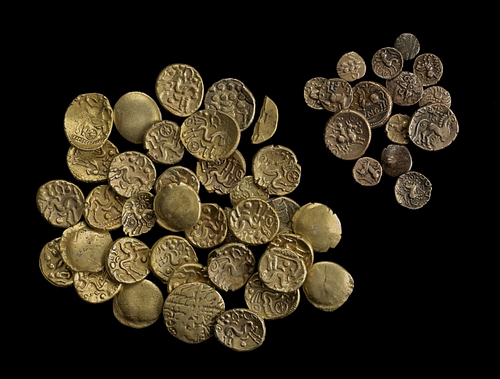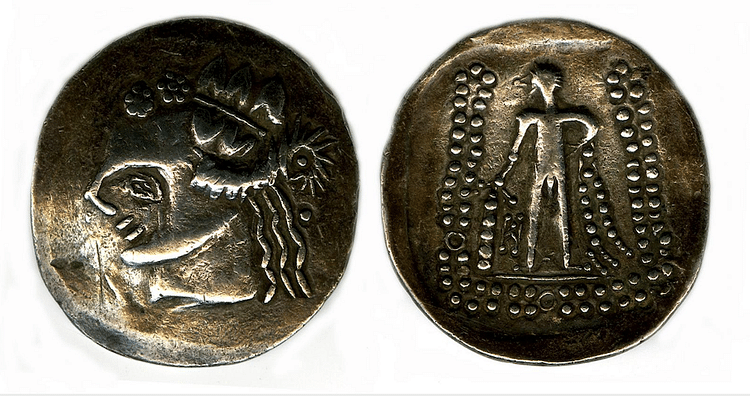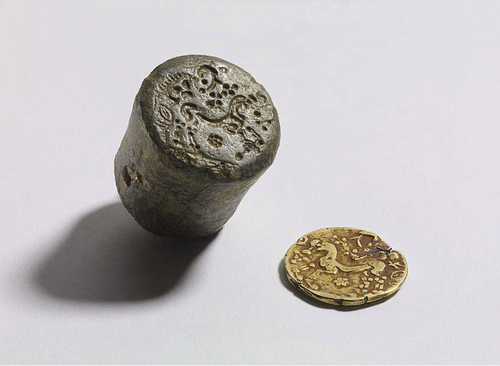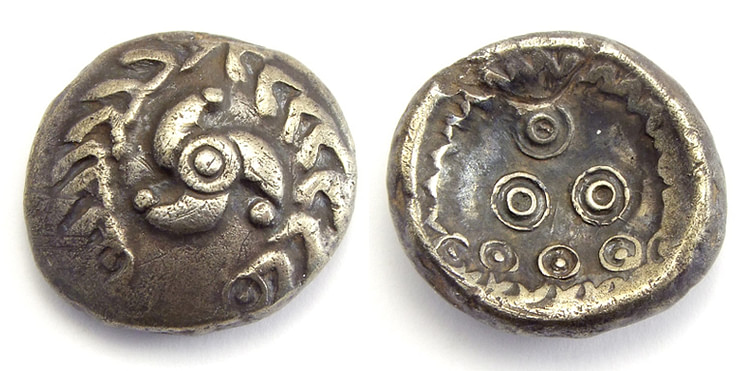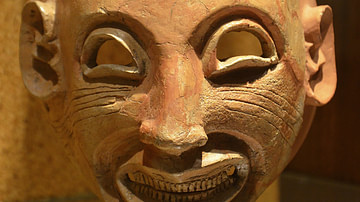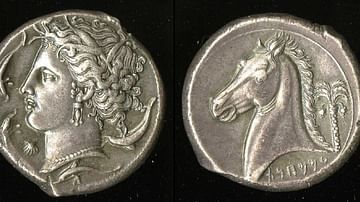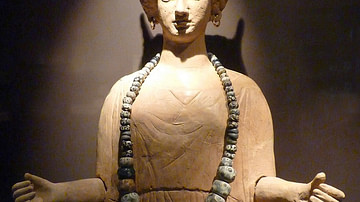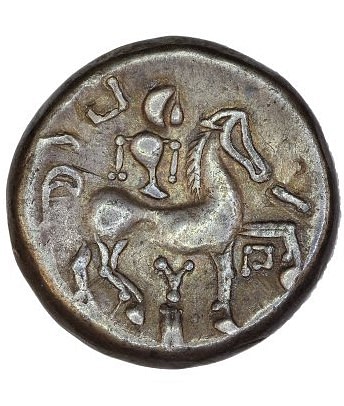
The coinage of the ancient Celts, minted from the early 3rd century BCE to the 1st century CE, at first imitated Greek and then Roman coins. Celtic engravers then soon developed their own unique style, creating distinctive coins with depictions of stylised horses, abstract shapes, and the portraits of Celtic chiefs. Not being part of a wider political and economic entity like the Roman Empire, gold, silver, and bronze Celtic coins were rarely used for interregional trade but were, rather, used to buy and exchange goods locally and to spread imagery of rulers, tribes, and the ancient Celtic religion. Finally, coins were frequently buried in large hoards as part of votive rituals.
The Function of Celtic Coinage
An enormous number of Celtic coins have been found in burials and as part of ritual treasure hoards across Europe. Some hoards contained as many as 10,000 coins. Celtic coins were used for a variety of reasons. They were, as one would expect, used as a currency to acquire goods locally but coins were primarily used as a more convenient replacement for other high-value goods which had previously been used in a barter system. Coins were also offered as diplomatic gifts and perhaps given as tribute to more powerful neighbouring rulers.
Coins were also minted for prestige reasons: to demonstrate the wealth and sophistication of a particular chief and to spread their likeness amongst the people they ruled. Coins were sometimes dispensed by chiefs to their people on special occasions as a demonstration of their success and generosity. It is for this reason, perhaps, that the minting of Celtic coins was so sporadic: only when a ruler needed extra legitimacy for their rule were new coins minted.
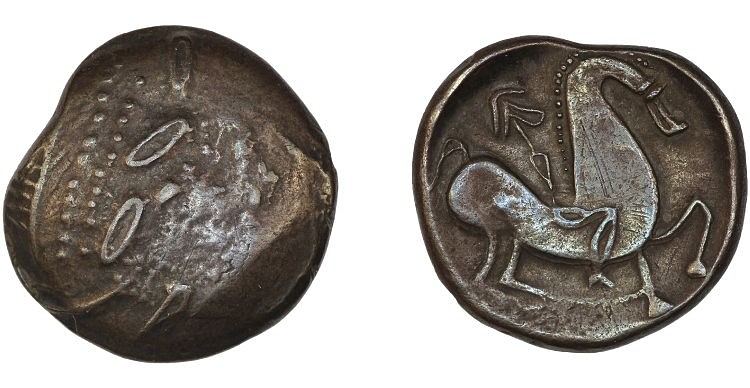
Although coins provided artists with a new medium to show off their skills, an unexpected consequence of their introduction on wider ancient Celtic art is here summarised by the historians J. Farley and F. Hunter:
The spread of coinage coincided with a rapid decline in the production of unique and ornately decorated objects: the shields, weapons and torcs that were both symbols of status and power, and the canvases for earlier Celtic art. As small, mass produced objects, coins are undoubtedly less impressive than the imposing metalwork that had gone before but they offered a new kind of impact. Rapid manufacture and portability allowed powerful images, political messages, and a newly transformed stock of Celtic art to be transmitted to a wider audience than ever before.
(110)
Celtic coins were rarely used in interregional trade since, unlike say in the Roman Empire, Celtic Europe was made up of many different tribal groups and the coinage of one had no value in another except for the weight of precious metal. It is for this reason that small scales have turned up everywhere in the archaeological record, needed to assess the real value of coins which were used in trade. A consequence of the necessity for a coin to have a real value as opposed to a face value was that should any chief be tempted to debase the metal in their coinage (and some did), they would find it of little use outside their own territory.
Finally, coins were frequently buried in hoards. However, this was not always a mere ‘bank in the ground’ strategy but likely involved some sort of specific ritual and was done as a votive offering to Celtic deities. Such deposits were added to over a period of many years, sometimes several decades, and were often divided into multiple hoards in the same vicinity. The site of Hallaton in England, for example, has been excavated by archaeologists, and they discovered over 5,000 coins buried in 16 different places. Nearby were remains of ritual animal sacrifices, further pointing to a religious significance to the burial of these coins.
Materials & Manufacture
Celtic coin makers were first inspired by gold and silver coins of the Greek world, particularly those coins minted during the reigns of Philip II of Macedon (r. 359-336 BCE) and Alexander the Great (r. 336-323 BCE). Such coins were brought back to central and western Europe by those Celtic warriors who had served as mercenaries in Hellenistic armies and those Celts in contact with the Greek colonies in southern France. The idea caught on in the early 3rd century BCE, and by the 2nd century BCE, there were multiple regions of Celtic Europe minting their own coins. Celtic coins were initially heavy and made from bronze, pure gold or silver, but later examples used alloys composed of copper, gold, and silver. The Parisii Gauls, who lived along the River Seine, were an interesting exception and used pure gold in all their issues. Meanwhile, the Cenomani in northeast Italy used cheap alloy material plated with gold.
There was a distinct preference for materials depending on geography, as here summarised by the historian B. Cunliffe:
Silver was the preferred medium in the Middle and Lower Danube, the Balkans, northern Italy, and southern France, while gold was preferred in the north in a zone stretching from Bohemia to southern Britain.
(269)
Celtic coins were rarely produced on a large scale so to describe their place of manufacture as a mint is perhaps too grand a term. Still, it is likely that such places as did make coins were most often located in the well-protected hillforts known as oppida which sprang up across Celtic Europe from the 2nd century BCE. Excavations at hillforts have revealed not only workshops for metalworkers and craftworkers but also the paraphernalia associated with coin manufacture.
Metal for coinage was first cast into disks in prepared moulds made of burnt clay. In such moulds, 50 or more blanks (often called flans) could be produced in a single go. This ensured that each coin was composed of a very similar weight of metal. Each circle of metal was then stamped with a design using an engraved die, one for each side of the coin. The minter placed the flan on top of the lower die, which was fixed in a clamp, and he then held the second die in his hand and hammered it on top of the flan, creating the design on both sides of the coin at the same time.
A fine example of a cylindrical die, made from a copper alloy, survives from Bredgar in Kent, England. Dating to the mid-2nd century BCE and discovered in a field by an amateur researcher using a metal detector, it was used to stamp designs of a stylised horse. The die is now in the British Museum in London. The design on the die is similar to Celtic coins minted in what is today Belgium and northern France, what numismatists rather unromantically call ‘Gallo-Belgi A’ type coins. The Bredgar die, then, illustrates the interconnected world of the Celts.
Designs
Greek coinage was copied at first, often without understanding the significance of the designs being imitated such as morphing horses and a chariot into a centaur. Designs even copied and adapted the faces of Hellenistic rulers or gods like Apollo. Sometimes small Celtic additions are made to the design such as a coin from Criciova (Romania) which shows the head of Zeus but with what appears to be a tattoo on his cheek. Then Roman coins inspired Celtic minters to put inscriptions on their coins, too. Most commonly the legends are abbreviated names of chiefs. Some coins in Britain carried the abbreviated name of regional capitals and, even more rarely, the name of the tribe that used them. An example of the latter type of inscription is the ECEN on the coins of the Iceni tribe.
Many Celtic coins, as in other forms of Celtic art, show animals such as boars, eagles, bulls, wolves, ravens, snakes, and imaginary beasts. Figures also have familiar Celtic objects such as torcs, cauldrons, and war horns. Favourite designs included the sun symbols which look like spoked wheels and horses, sometimes with a female rider. Examples in silver and gold of these types have been found across Europe. The horse is remarkably similar in different regions: highly stylised and with distinctive rounded knee joints. Horses sometimes have a triple tail, a human head, or a bird flying above them, or they can be increasingly abstract as Celtic artists distanced themselves from the Greek originals. Even when the subjects are clearly Greek-inspired, such as a figure of Hercules with his familiar club and lion skin, the designs can be uniquely Celtic. One fine example from the Balkans, now in the British Museum, shows such a Hercules as a stick figure and his possessions as only a series of dots. By the 1st century BCE, the horse continues to be popular but coins also show an increasing amount of abstract shapes whose precise significance is now lost to us. The coins of the Taurisci in Slovenia during the 1st century BCE, for example, show masks, dots, and swirling forms but the relationship between these symbols is not known.
As in many other cultures, coins were a handy form of political propaganda and helped spread the imagery, power, and prestige of Celtic chiefs by carrying their portraits. In France, 27 gold coins dating to 52 BCE have been found depicting a youthful Vercingetorix (l. 82-46 BCE), the famous Gallic chief. Silver coins of the Aedui chief Dumnorix, which date to c. 50 BCE, show a profile of the chief on one side while on the other is a Celtic warrior holding a decapitated head and a war horn (carnyx).
Some regions did produce entirely unique designs and forms such as the gold, silver, or electrum Regenbogenschüsselchen of southern Germany and Bohemia. These coins have a form like a miniature bowl and were inspired by the belief that rainbows, when their ends struck the ground, left a dish-shaped area of gold. Regenbogenschüsselchen were often given images of torcs, birds’ heads, globes, or abstract linear designs and shapes. In the Middle Ages, it was believed that finding these ancient Celtic coins in fields or wherever else they might turn up brought good luck and health.
